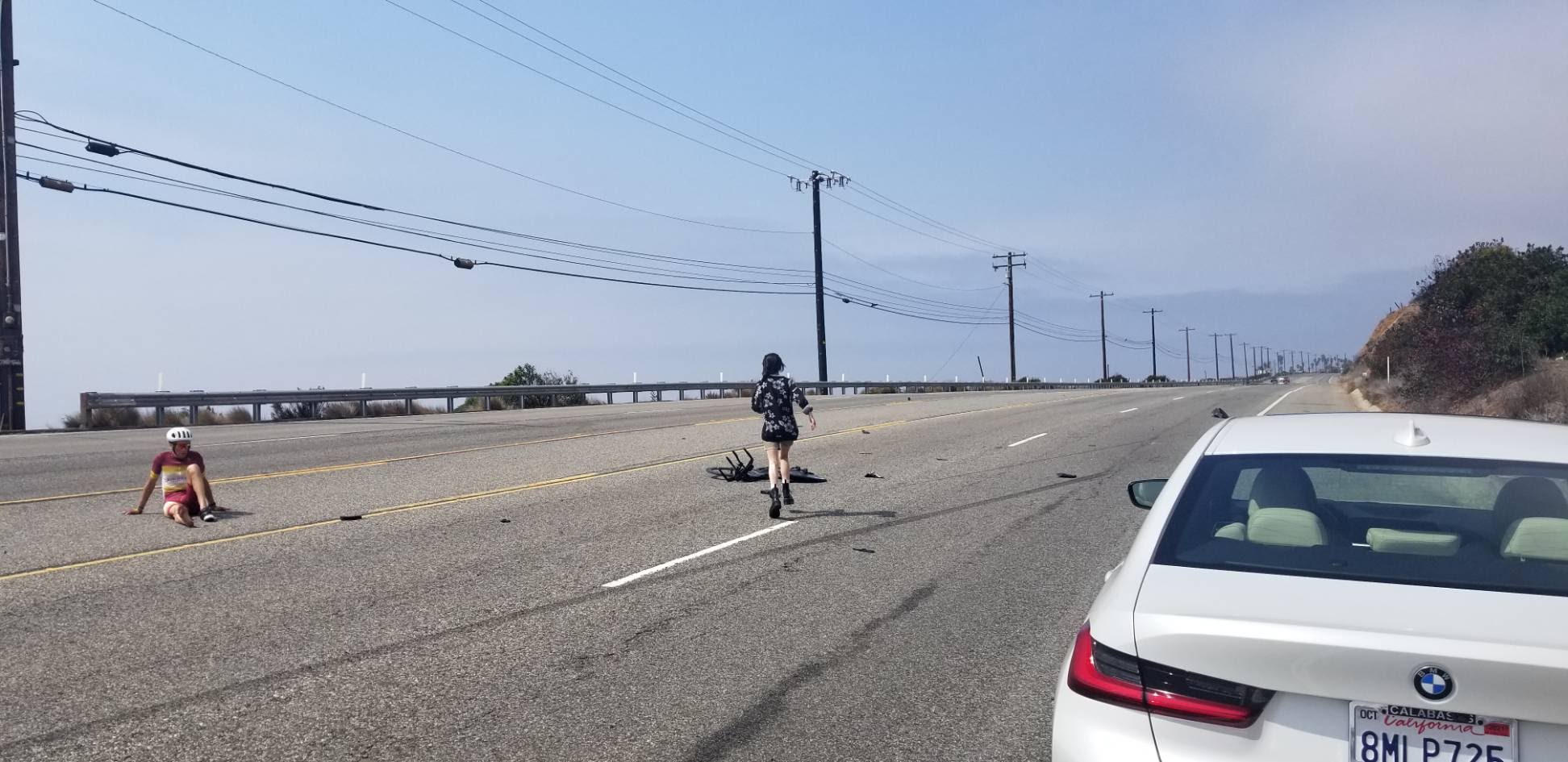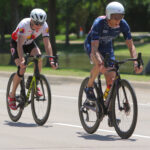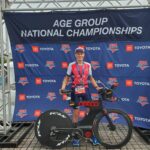Every cyclist and triathlete recognizes, understands, and accepts the risks they are taking every time they climb into the saddle and go for a road ride. A distracted or reckless driver can mean serious injury or death. But, in my years of cycling and triathlon training and racing, I have avoided such intimate contact with an automobile…until recently.
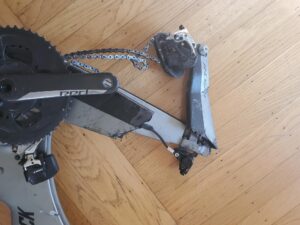 On Friday, September 24th, during my final training ride on Pacific Coast Highway before the Malibu Triathlon this past weekend, I was hit by a car. Even crazier was that it was a hit and run with the driver showing no signs of slowing down after the collision (the California Highway Patrol told me that the chances of apprehending the driver was next to nil). Actually, the car hit the rear of my bike. The bad news is that my bike was obliterated. The good news is that I wasn’t obliterated; I only sustained relatively minor injuries (emphasis on ‘relatively’). After nine hours at the UCLA Level 1 Trauma Center (I will describe that experience in a future article), I was released with a broken bone fragment in my right foot, two small, nondisplaced fractures on my tibial plateau, and eight stitches in two lacerations on my right calf. I was VERY fortunate!! If the point of collision had been one foot to the left, I would be seriously injured or dead. Instead, I’m on crutches for a minimum of six weeks, but with no cast, brace, or boot. My orthopedist has also cleared me to swim, water run, and do strength exercises around my injury, so I can maintain my range of motion and minimize atrophy and loss of strength.
On Friday, September 24th, during my final training ride on Pacific Coast Highway before the Malibu Triathlon this past weekend, I was hit by a car. Even crazier was that it was a hit and run with the driver showing no signs of slowing down after the collision (the California Highway Patrol told me that the chances of apprehending the driver was next to nil). Actually, the car hit the rear of my bike. The bad news is that my bike was obliterated. The good news is that I wasn’t obliterated; I only sustained relatively minor injuries (emphasis on ‘relatively’). After nine hours at the UCLA Level 1 Trauma Center (I will describe that experience in a future article), I was released with a broken bone fragment in my right foot, two small, nondisplaced fractures on my tibial plateau, and eight stitches in two lacerations on my right calf. I was VERY fortunate!! If the point of collision had been one foot to the left, I would be seriously injured or dead. Instead, I’m on crutches for a minimum of six weeks, but with no cast, brace, or boot. My orthopedist has also cleared me to swim, water run, and do strength exercises around my injury, so I can maintain my range of motion and minimize atrophy and loss of strength.
As many cyclists and triathletes have experienced accidents on their bikes, whether a crash or a collision by a car, I thought it would be interesting to share my recent experience through the lens of both a cyclist and a sport psychologist.
 Let me begin with my psychology immediately after the crash. Much to my surprise, I felt neither extreme fear nor shock. Through the initial aftermath, I was calm and lucid. I felt no strong emotions, nor did I have a significant stress reaction (which I would have expected). The EMTs were worried because my heart rate was very low, only 49 bpm, but I told them that my waking HR is 40. Moreover, as the day progressed and throughout my treatment at the trauma center, my emotions ranged from equanimity to a strange sense of exhilaration.
Let me begin with my psychology immediately after the crash. Much to my surprise, I felt neither extreme fear nor shock. Through the initial aftermath, I was calm and lucid. I felt no strong emotions, nor did I have a significant stress reaction (which I would have expected). The EMTs were worried because my heart rate was very low, only 49 bpm, but I told them that my waking HR is 40. Moreover, as the day progressed and throughout my treatment at the trauma center, my emotions ranged from equanimity to a strange sense of exhilaration.
Research has shown that reactions to near-death experiences are highly idiosyncratic, with some people experiencing debilitating fear and long-term Post-traumatic Stress Disorder (PTSD), while others describe a short-term state of calm and a long-term loss of fear of death. I may have fallen into the latter category; thus, my feeling of tranquility immediately after the collision and the ensuing feeling of, well, lightness and freedom that may have been caused by a loss of fear of death. I also have to admit that I feel like I can now where a badge of honor for joining the “hit by a car” club (not something to aspire to, to be sure). Or, less romantic in its perspective, I may just be happy to be alive!
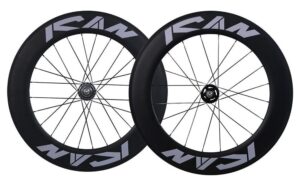 I work with athletes in high-risk sports (e.g., cycling, ski racing) and those who have been injured by those risks, so I was acutely aware of the typical negative reactions that arise following a serious accident. Persistent fear, obsessive replaying of the traumatizing event, an ongoing stress reaction (e.g., anxiety, body tension, hypersensitivity), and avoidance of similar situations in the future are common. That’s why so many people stop cycling outside after a bike accident.
I work with athletes in high-risk sports (e.g., cycling, ski racing) and those who have been injured by those risks, so I was acutely aware of the typical negative reactions that arise following a serious accident. Persistent fear, obsessive replaying of the traumatizing event, an ongoing stress reaction (e.g., anxiety, body tension, hypersensitivity), and avoidance of similar situations in the future are common. That’s why so many people stop cycling outside after a bike accident.
Paradoxically, this reaction is intended to help people cope with trauma. PTSD symptoms evolved as a survival mechanism: being in a state of high alert to potential dangers helped our primitive forebearers to survive similar encounters in the future. Unfortunately, as with so many of these formerly adaptive reactions, PTSD can be dysfunctional in modern life because the reactions are extreme and persist far beyond their usefulness.
Despite my sanguine state in the days following the hit-and run, I couldn’t be sure whether my good feelings and absence of PTSD symptoms would continue, so I have taken active steps to prevent such a reaction from arising in the future because I, for one, didn’t want to be one of those people who give up our beloved sport.
Imagery Rescripting
How well we remember traumatic events also has survival value. Our brains want to make sure that we remember such events so when they arise in the future, we are more likely to avoid them ore prevent them from happening. Research has found that emotionally laden memories are consolidated into long-term memory more readily and more deeply than non-emotional memories. And a bike crash, like the one I experienced, is super-charged emotionally.
To reduce the chances that the emotionally intense memories of my unfortunate encounter with a car will get consolidated into my long-term memory, I used a therapeutic technique called ‘imagery rescripting’ that involves replaying and correcting the tr

aumatic event. Other research from the military that I read several years ago (which I can’t find the reference for) further indicated the imagery rescripting will be most effective if used repeatedly in the first 24-48 hours for the emotional memories have had time to gain traction in our gray matter.
Within hours of the accident, I began replaying my memory of it in my mind’s eye. Not surprisingly, my imagery was decidedly negative, meaning I was just replaying the terrifying experience which only served to augment, rather than disrupt, the memory consolidation process. Using many of the strategies that I use with my athletes, including using slow-motion imagery and imagery editing, I literally forced my mind to run another script.
I tried several different scripts. The first was to simply erase the car from my memory of the crash. This was a total failure as it kept popping back into my imagined replays. I then tried to slow it down, so I and the driver had time to avoid the collision. This too failed as the memory of the speeding car coming at me would not release its grip on my psyche. Finally, I came upon a script to which my brain was more amenable. I imagined the car bearing down on me and, through a combination of my pedaling harder and the car swerving, I was able to see the car narrowly missing me.
 Having landed on this script, I replayed the experience, but rewrote the script. Over the next two days (and continually to this day), I reimagined and corrected my violent meeting with the car hundreds of times. Because I have blocked the emotional memory of the collision from becoming consolidated in my brain, I can replay the amended script with little effort. And, importantly, I have no emotional reaction when I recall the incident. Admittedly, on occasion, I also inadvertently run through my mind an even worse-than-reality scenario in which I’m hit head on and see myself being thrown high in the air. But when this happens, in another use of imagery rescripting, while also creating a feeling of power over the situation, I see myself actually flying like a superhero and landing safely on the ground.
Having landed on this script, I replayed the experience, but rewrote the script. Over the next two days (and continually to this day), I reimagined and corrected my violent meeting with the car hundreds of times. Because I have blocked the emotional memory of the collision from becoming consolidated in my brain, I can replay the amended script with little effort. And, importantly, I have no emotional reaction when I recall the incident. Admittedly, on occasion, I also inadvertently run through my mind an even worse-than-reality scenario in which I’m hit head on and see myself being thrown high in the air. But when this happens, in another use of imagery rescripting, while also creating a feeling of power over the situation, I see myself actually flying like a superhero and landing safely on the ground.
Regain Control of the Narrative
Overcoming the trauma of a bad bike crash isn’t just about rewiring your brain. It also involves recognizing that such a distressing experience also changes the way you think and how you talk to yourself. Perhaps the most psychologically harmful aspect of such a distressing event is the feelings of loss of control and helplessness. In this vulnerable state, symptoms of PTSD increase because you feel powerless to do anything about what happened that caused the reaction in the future.
This victim mentality can lead to thinking that further inculcates a fearful mindset that will create more distress. To counteract the feeling of vulnerability and the negative thinking that follows from it, I put myself on a regimen of positive thinking. In recent days, anytime I felt myself going to the “dark side” (if you’re a Star Wars fan), I would begin a litany of positive self-statements aimed at instilling feelings of power and control (e.g., “I choose how I will react to this trauma.” “I am strong.” “I will not let this event dictate my life.”). As these statements became a regular mantra, I could feel myself feel more powerful and the accident seemed to move farther away from me.
Be Rational
When a highly traumatic event occurs, our pre-frontal cortex, which is involved in what is called ‘executive functioning’ (e.g., self-monitoring, planning, weighing options, self-control, decision making) becomes largely disabled. At the same time, the brain’s limbic system, which is responsible for the processing of and reaction to emotional information, takes control (called ‘emotional hijack’). Evolutionarily speaking, this disruption was essential for our survival when we were living on the Serengeti 250,000 years ago and didn’t have time to think through what our options were (in that time on reflection we would have been eaten by the saber-toothed tiger or killed by the rival tribespeople). Instead, our limbic system ensured an immediate reaction that increased our chances of survival (fight, freeze, or flight!).
 But what worked then doesn’t work now and certainly wasn’t going to serve me well as I rehabilitated my body and my mind from the trauma of the collision with the car. Instead, I needed to get my limbic system to relinquish control and allow my pre-frontal cortex to take over the captain’s chair of my life. To that end, I began to challenge the irrational thinking that can perpetuate PTSD reactions.
But what worked then doesn’t work now and certainly wasn’t going to serve me well as I rehabilitated my body and my mind from the trauma of the collision with the car. Instead, I needed to get my limbic system to relinquish control and allow my pre-frontal cortex to take over the captain’s chair of my life. To that end, I began to challenge the irrational thinking that can perpetuate PTSD reactions.
I reminded myself that, though there are certainly risks to riding a bike, being hit by a car is still statistically unlikely. This belief is often difficult to embrace, particularly in the cycling and triathlon worlds where almost everyone I told about my accident either had been hit themselves or knew someone who was. But these incidences can cause people to engage in a cognitive bias called overgeneralization in which an inaccurate conclusion is drawn from a limited or nonrepresentative sample of data. In fact, 70% of fatal bike accidents occur in cities, among less experienced cyclists, and those who don’t follow basic traffic rules. Assuming that you follow the rules and ride safely, the chances of being hit by a car are very low.
Be Grateful
Gratitude is perhaps the emotion I have been feeling the most since my unfortunate meeting of bike with car. Though I did sustain injuries that have prematurely ended my triathlon season, I am painfully aware that the consequences of my collision could have been much worse.
Additionally, though the driver who hit me and didn’t stop speaks of the callousness that exists in the world, I am also grateful to the good Samaritans who did stop and took care of me in the immediate aftermath of the crash. One woman called 911 and sat with me on the side of the road. One man jumped in this car and tried to chase the hit-and-run driver (to no avail; he was long gone). Another man took my car key and moved it in Malibu to a street where I wouldn’t get towed.
I am incredibly grateful to the medical professionals, from the Los Angeles County EMTs who arrived first on the scene to the physicians, nurses, and other staff at the UCLA Trauma Center who made sure I wasn’t seriously and treated the injuries I did sustain.
I feel gratitude for the CHP officers who collected my broken bike, stored it at their station, and took pictures of its gnarled remains. The same for Steve Dozier from Wheel World in Woodland Hills, California, who went beyond the call of duty to drive to the CHP station, pick up my bike, and then box and ship it back to me so it could be stripped of its functioning parts and then given a proper burial.
I am appreciative of those in the triathlon and cycling community who have reached out to express their caring of and support for me during this difficult time.
I am grateful to my wife and daughters whom I worried more than I wanted to when I told them the news, but who have been loving and supportive during my recovery, and who are allowing me to continue to ride my bike outside when I return to health.
Finally, I feel the deepest gratitude that, despite this decidedly unnerving experience, I will return to riding my bike soon (perhaps with a little bit of trepidation at first) and continue to do this amazing sport that we all love.
- Read my Triathlon blog.
- Listen to my Train Your Mind for Athletic Success
- Read my latest mental training book: Train Your Mind for Athletic Success: Mental Preparation to Achieve Your Sports Goals.
- Take a look at myonline mental training courses.
- Schedule a 1:1 session with me.

